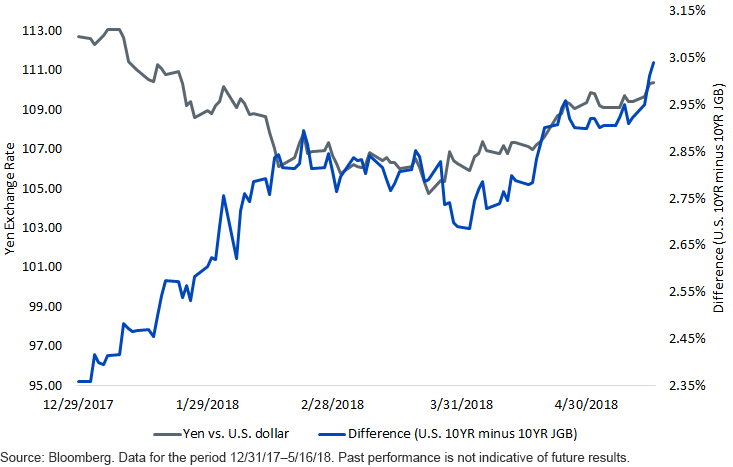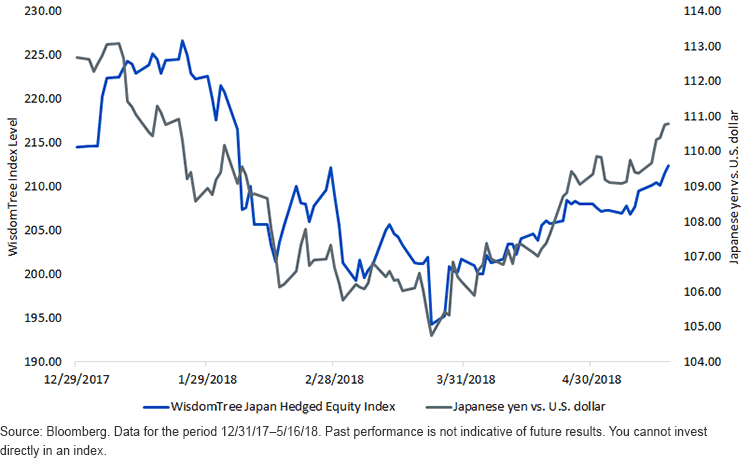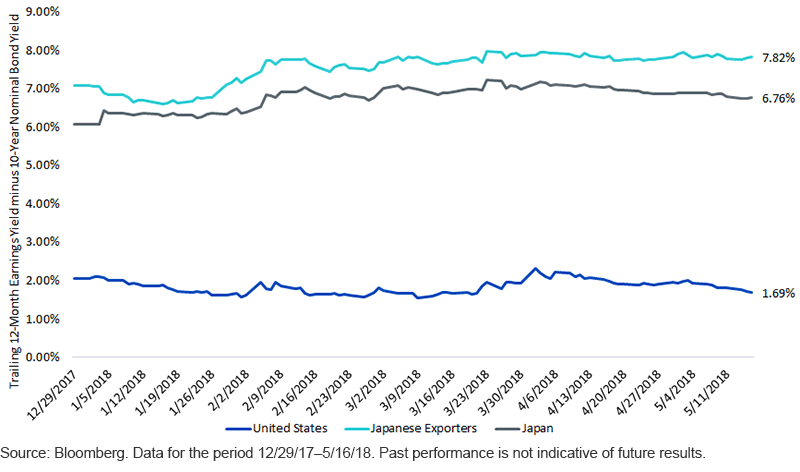Breaking Through 3.05% on U.S. 10-Year Notes Could Spell Opportunity in Japan


So, it has happened. As of this writing, the U.S. 10-Year Treasury note has seen its yield break through the much-discussed 3.05% resistance level—something we haven’t seen since 2011.
What does that mean for equities globally?
Japan as a Play on Rising U.S. Interest Rates
Over the years, we have written often on the concept of using Japanese equities as a play on rising U.S. interest rates. In the current regime, this makes a lot of sense because:
- The Bank of Japan (BOJ) is holding the 10-year Japanese government bond (JGB) interest rate close to 0%. In normal circumstances, global interest rates would move in some relationship to U.S. interest rates, but clearly this wouldn’t occur today.
- This leads to a transmission mechanism for the move that would otherwise occur in Japan’s government bond market to occur in Japan’s currency market versus the U.S. dollar. Rising U.S. rates—all other things being equal—should encourage Japan’s currency to weaken against the U.S. dollar.
The 2018 Experience: Have 10-Year Interest Rate Differentials Affected Currency Moves?

We wanted to test this hypothesis in relation to whether there was any discernible relationship between the difference in 10-year interest rates in the U.S. and Japan and the behavior of the yen.
- During the month of January, the difference between the U.S. 10-Year note and the Japanese 10-year JGB was widening. At the same time, the yen was strengthening. Clearly, our hypothesis of widening interest rate differentials and weakening yen was challenged during this period.
- In February 2018, the relationship changed. Yes, the yen continued to strengthen, but the difference between the U.S. 10-Year note and Japanese 10-year JGB interest rates actually began to fall. March 23, 2018, saw the strongest level of the yen that we’ve observed thus far in 2018. After that point, the yen weakened, and it is clear that the gap between the U.S. and Japanese government rates was also widening.
In 2018, the Yen (Like in Other Years) Heavily Influenced the Equity Experience

- Japanese equities are well known for the negative correlation of their returns to movements in exchange rate between the yen and the U.S. dollar. We can see here that, from the beginning of 2018 until approximately March 23, the yen was getting stronger and the WisdomTree Japan Hedged Equity Index was dropping. From March 23 to the present, the yen has been getting weaker and Japan’s equities have been appreciating.
- With the U.S. 10-Year Treasury seeing its yield break through the 3.05% resistance level, and assuming the BOJ continues its current policy for the foreseeable future, a widening differential could support continued depreciation of the yen. If this relationship holds, this can be quite positive for Japan’s equities.
Valuations Support Japan’s Exporters Very Strongly
While Japan’s equity market is generally characterized by a negative correlation between its returns and those of the yen, there are differences across sectors. Utilities and Telecommunication Services, for example, are very domestically driven—meaning their revenues and earnings are less dependent on the yen’s moves, whereas Industrials and Consumer Discretionary companies are major exporters.
For those looking at Japan over the past six years, their “yen experience” has varied massively.
- In 2012 prior to the December 16 election of Prime Minister Shinzo Abe, the exchange rate was around ¥80 to the dollar. Our current levels of ¥110–111 to the dollar clearly are much weaker.
- In July 2015, the rate hit levels of ¥125–126 to the dollar; looking from this perspective, the yen has strengthened significantly.
- 2016 was interesting, in that we saw the rate go from about ¥120 to ¥99 and change, and then back almost all the way to ¥120.
The bottom line: While it would have been a great story to see the rate move in a straight line from levels around ¥80 to levels above ¥120 and beyond, this hasn’t happened. The result is that, without a crystal-clear direction on the currency, export-oriented stocks within Japan have tended to trade at less-expensive valuations than Japan’s broad market.
Japan’s Exporters: Valuation Advantage over Japan’s Market as Well as U.S. Equities

Conclusion: Low Expectations and Yen Weakness Could Open the Door for Japan’s Exporters to Break Out in 2018
My colleague Jesper Koll has written about expectations of company earnings in Japan being fairly low and headed for a potential break out. If this is combined with a global macroeconomic backdrop that encourages the yen to continue to weaken, Japan’s exporters could see a very strong second half to 2018.

Christopher Gannatti began at WisdomTree as a Research Analyst in December 2010, working directly with Jeremy Schwartz, CFA®, Director of Research. In January of 2014, he was promoted to Associate Director of Research where he was responsible to lead different groups of analysts and strategists within the broader Research team at WisdomTree. In February of 2018, Christopher was promoted to Head of Research, Europe, where he was based out of WisdomTree’s London office and was responsible for the full WisdomTree research effort within the European market, as well as supporting the UCITs platform globally. In November 2021, Christopher was promoted to Global Head of Research, now responsible for numerous communications on investment strategy globally, particularly in the thematic equity space. Christopher came to WisdomTree from Lord Abbett, where he worked for four and a half years as a Regional Consultant. He received his MBA in Quantitative Finance, Accounting, and Economics from NYU’s Stern School of Business in 2010, and he received his bachelor’s degree from Colgate University in Economics in 2006. Christopher is a holder of the Chartered Financial Analyst Designation.

